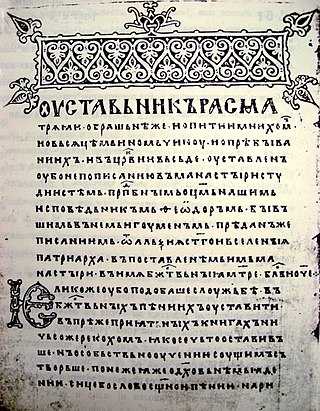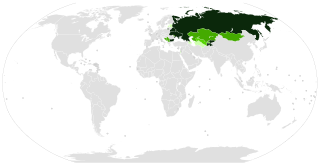
The Slavic languages, also known as the Slavonic languages, are Indo-European languages spoken primarily by the Slavic peoples and their descendants. They are thought to descend from a proto-language called Proto-Slavic, spoken during the Early Middle Ages, which in turn is thought to have descended from the earlier Proto-Balto-Slavic language, linking the Slavic languages to the Baltic languages in a Balto-Slavic group within the Indo-European family.

Old Church Slavonic or Old Slavonic is the first Slavic literary language.

The Russian alphabet is the script used to write the Russian language. It comes from the Cyrillic script, which was devised in the 9th century for the first Slavic literary language, Old Slavonic. Initially an old variant of the Bulgarian alphabet, it became used in the Kievan Rusʹ since the 10th century to write what would become the modern Russian language.

Church Slavonic, also known as Church Slavic, New Church Slavonic, New Church Slavic or just Slavonic, is the conservative Slavic liturgical language used by the Eastern Orthodox Church in Belarus, Bulgaria, North Macedonia, Montenegro, Poland, Ukraine, Russia, Serbia, the Czech Republic and Slovakia, Slovenia and Croatia. The language appears also in the services of the Russian Orthodox Church Outside of Russia, the American Carpatho-Russian Orthodox Diocese, and occasionally in the services of the Orthodox Church in America.
A yer is either of two letters in Cyrillic alphabets, ъ and ь. The Glagolitic alphabet used, as respective counterparts, the letters (Ⱏ) and (Ⱐ). They originally represented phonemically the "ultra-short" vowels in Slavic languages, including Old Church Slavonic, and are collectively known as the yers.

The Bulgarian Cyrillic alphabet is used to write the Bulgarian language. The Cyrillic alphabet was originally developed in the First Bulgarian Empire during the 9th – 10th century AD at the Preslav Literary School.

The soft sign is a letter in the Cyrillic script that is used in various Slavic languages. In Old Church Slavonic, it represented a short or reduced front vowel. However, over time, the specific vowel sound it denoted was largely eliminated and merged with other vowel sounds.

Yeru or Eru, usually called Y in modern Russian or Yery or Ery historically and in modern Church Slavonic, is a letter in the Cyrillic script. It represents the close central unrounded vowel after non-palatalised (hard) consonants in the Belarusian and Russian alphabets, and after any consonant in most of Rusyn standards, where it represents the unrounded close-mid back unrounded vowel sound.

Э э is a letter found in three Slavic languages: Russian, Belarusian, and West Polesian. It represents the vowels and, as the e in the word "editor". In other Slavic languages that use the Cyrillic script, the sounds are represented by Ye (Е е), which represents in Russian and Belarusian in initial and postvocalic position or and palatalizes the preceding consonant. This letter closely resembles and should not be confused with the older Cyrillic letter Ukrainian Ye, of which Э is a reversed version.

The Balto-Slavic languages form a branch of the Indo-European family of languages, traditionally comprising the Baltic and Slavic languages. Baltic and Slavic languages share several linguistic traits not found in any other Indo-European branch, which points to a period of common development and origin.

The Ukrainian alphabet is the set of letters used to write Ukrainian, which is the official language of Ukraine. It is one of several national variations of the Cyrillic script. It comes from the Cyrillic script, which was devised in the 9th century for the first Slavic literary language, called Old Slavonic. In the 10th century, it became used in Kievan Rus' to write Old East Slavic, from which the Belarusian, Russian, Rusyn, and Ukrainian alphabets later evolved. The modern Ukrainian alphabet has 33 letters in total: 21 consonants, 1 semivowel, 10 vowels and 1 palatalization sign. Sometimes the apostrophe (') is also included, which has a phonetic meaning and is a mandatory sign in writing, but is not considered as a letter and is not included in the alphabet.
The history of the Slavic languages stretches over 3000 years, from the point at which the ancestral Proto-Balto-Slavic language broke up into the modern-day Slavic languages which are today natively spoken in Eastern, Central and Southeastern Europe as well as parts of North Asia and Central Asia.

The letter Ъ ъ of the Cyrillic script is known as er goläm in the Bulgarian alphabet, as the hard sign in the modern Russian and Rusyn alphabets, as the debelo jer in pre-reform Serbian orthography, and as ayirish belgisi in the Uzbek Cyrillic alphabet. The letter is called back yer or back jer and yor or jor in the pre-reform Russian orthography, in Old East Slavic, and in Old Church Slavonic.

Numerous Cyrillic alphabets are based on the Cyrillic script. The early Cyrillic alphabet was developed in the 9th century AD and replaced the earlier Glagolitic script developed by the theologians Cyril and Methodius. It is the basis of alphabets used in various languages, past and present, Slavic origin, and non-Slavic languages influenced by Russian. As of 2011, around 252 million people in Eurasia use it as the official alphabet for their national languages. About half of them are in Russia. Cyrillic is one of the most-used writing systems in the world. The creator is Saint Clement of Ohrid from the Preslav literary school in the First Bulgarian Empire.
The following list is a comparison of basic Proto-Slavic vocabulary and the corresponding reflexes in the modern languages, for assistance in understanding the discussion in Proto-Slavic and History of the Slavic languages. The word list is based on the Swadesh word list, developed by the linguist Morris Swadesh, a tool to study the evolution of languages via comparison, containing a set of 207 basic words which can be found in every language and are rarely borrowed. However, the words given as the modern versions are not necessarily the normal words with the given meaning in the various modern languages, but the words directly descended from the corresponding Proto-Slavic word. The list here is given both in the orthography of each language, with accent marks added as necessary to aid in pronunciation and Proto-Slavic reconstruction. See below for a capsule summary of how to pronounce each language, as well as some discussion of the conventions used.
This article discusses the phonological system of the Bulgarian language.

Yo, Jo or Io is a letter of the Cyrillic script. In Unicode, the letter ⟨Ё⟩ is named CYRILLIC CAPITAL/SMALL LETTER IO.
This article discusses the phonological system of standard Russian based on the Moscow dialect. For an overview of dialects in the Russian language, see Russian dialects. Most descriptions of Russian describe it as having five vowel phonemes, though there is some dispute over whether a sixth vowel,, is separate from. Russian has 34 consonants, which can be divided into two types:

Proto-Slavic is the unattested, reconstructed proto-language of all Slavic languages. It represents Slavic speech approximately from the 2nd millennium BC through the 6th century AD. As with most other proto-languages, no attested writings have been found; scholars have reconstructed the language by applying the comparative method to all the attested Slavic languages and by taking into account other Indo-European languages.
The Proto-Slavic language, the hypothetical ancestor of the modern-day Slavic languages, developed from the ancestral Proto-Balto-Slavic language, which is the parent language of the Balto-Slavic languages. The first 2,000 years or so consist of the pre-Slavic era, a long period during which none of the later dialectal differences between Slavic languages had yet emerged. The last stage in which the language remained without internal differences that later characterize different Slavic languages can be dated around AD 500 and is sometimes termed Proto-Slavic proper or Early Common Slavic. Following this is the Common Slavic period, during which the first dialectal differences appeared but the entire Slavic-speaking area continued to function as a single language, with sound changes tending to spread throughout the entire area. By around 1000, the area had broken up into separate East Slavic, West Slavic and South Slavic languages, and in the following centuries it broke up further into the various modern Slavic languages of which the following are extant: Belarusian, Russian, Rusyn and Ukrainian in the East; Czech, Slovak, Polish, Kashubian and the Sorbian languages in the West, and Bulgarian, Macedonian, Serbo-Croatian and Slovenian in the South.


















